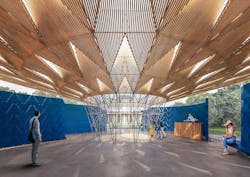Tree Pose
Burkina Faso-born Francis Kéré was selected to design the Serpentine Pavilion, a temporary installation at the Serpentine Gallery, Kensington Garden, London. His Berlin-based practice has designed everything from schools to retail environments. Kéré’s installation addresses how people move through the gardens while they interact with one another. “I was interested in how my contribution to this Royal Park could not only enhance the visitors’ experience of nature, but also provoke a new way for people to connect with each other,” says Kéré.
Kéré’s pavilion speaks to the ecological and social value of trees. “It is a micro cosmos that fuses cultural references from my home country of Burkina Faso with experimental construction techniques,” says Kéré of the pavilion design; he goes on to explain that in Burkina Faso, a tree is a public gathering place where life plays out, making it a fitting archetype for a pavilion design. Branches and foliage provide shelter with a feeling of openness to the community—a fundamental element of all Kéré’s architecture.
Like a tree, the structure responds to London’s climate; four curved walls form an enclosure, yet offer four entry points. The walls themselves exhibit a transparent nature in a cellular structure formed by wooden blocks assembled into triangular modules with tiny apertures.
Supported by a central steel framework, the roof canopy perches above the walls, and the void between them acts as transom window would to provide constant, natural ventilation. An oculus is open to the sky for rain collection, and becomes a functional water feature reminding occupants of the essential, life-giving element. After dark, the pavilion becomes a lantern as perforations in the structure allow light and movement to be detected by others seeking out the gathering spot.
